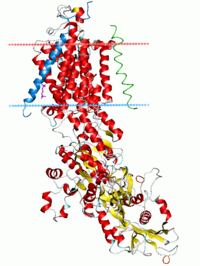
Photo from wikipedia
P-type ATPase are present in nearly all organisms. They maintain electrochemical gradients for many solutes, in particular ions, they control membrane lipid asymmetry, and are crucial components of intricate signaling… Click to show full abstract
P-type ATPase are present in nearly all organisms. They maintain electrochemical gradients for many solutes, in particular ions, they control membrane lipid asymmetry, and are crucial components of intricate signaling networks. All P-type ATPases share a common topology with a transmembrane and three cytoplasmic domains and their transport cycle follows a general scheme - the Post-Albers-cycle. Recently, P-type ATPase research has been advanced most significantly by the technological advancements in cryo-EM analysis, which has elucidated many new P-type ATPase structures and mechanisms and revealed several new ways of regulation. In this review, we highlight the progress of the field and focus on special features that are present in the five subfamilies. Hence, we outline the new intersubunit transport model of KdpFABC, the ways in which heavy metal pumps have evolved to accommodate various substrates, the strategies Ca2+ pumps utilize to adapt to different environmental needs, the intricate molecular builds of the ion binding sites in Na,K- and H,K-ATPases, the remarkable hexameric assembly of fungal proton pumps, the many ways in which P4-ATPase lipid flippases are regulated, and finally the deorphanization of P5 pumps. Interestingly many of the described features are found in more than one of the five subfamilies, and mixed and matched together to provide optimal function and precise regulation.
Journal Title: Biochemical Society transactions
Year Published: 2023
Link to full text (if available)
Share on Social Media: Sign Up to like & get
recommendations!